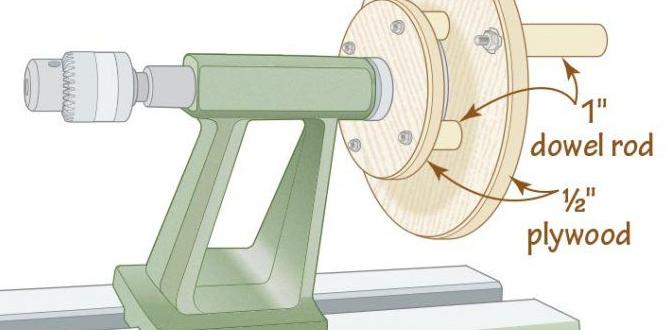For creating tiny, intricate pockets in tough materials like carbon steel, a Tialn ball nose end mill with a 45-degree helix angle is your secret weapon. It offers superior chip evacuation and precise control, making those challenging small pocket jobs achievable and clean.
Ever stared at a detailed drawing, a tiny pocket that needs to be just right, and felt a twinge of worry about how to achieve it? Especially when that pocket is in a material as stubborn as carbon steel? You’re not alone! Machining small features can be tricky. You need the right tool that’s not just sharp, but also smart enough to handle tight spaces and tough metals. That’s where the Tialn ball nose end mill with a 45-degree helix angle shines. It’s designed to tackle these exact challenges, giving you confidence and clean results, even on your first try. Let’s dive into why this specific tool is such a game-changer for small pocket work.
Unlock Precision: The Magic of the 45-Degree Tialn Ball Nose End Mill for Small Pockets
Imagine you need to machine a small, rounded corner inside a part or create a tiny semi-circular recess. For these intricate jobs, a standard end mill might struggle. It can leave unwanted tool marks, overheat, or even break under pressure. This is where specialized tooling comes into play. The Tialn ball nose end mill, particularly one with a 45-degree helix angle and a Tialn coating, is engineered to solve these precise problems. It’s not just about having a round tip; it’s about how that tip interacts with the material, especially tough ones like carbon steel, and how it manages the cutting process in confined spaces.
Why “Ball Nose” Matters for Small Pockets
A ball nose end mill has a fully rounded cutting edge at its tip, unlike flat-bottomed end mills. This shape is crucial for several reasons, especially when working with small pockets:
- Creating Radii: The most obvious benefit is its ability to create perfectly radiused internal corners. This is essential for functional parts where stress concentration needs to be minimized or for aesthetic reasons.
- Smooth Finishes: The rounded geometry allows for smoother surface finishes with fewer scallops compared to a flat end mill trying to create a similar shape.
- Adaptive Cutting: A ball nose end mill can cut in any direction, including plunging and profiling, making it versatile for complex 3D shapes and intricate pocketing.
The Significance of the 45-Degree Helix Angle
The helix angle is the angle of the flutes (the cutting edges) that wrap around the tool. While common end mills might have 30-degree or even 0-degree helix angles, a 45-degree angle offers a sweet spot for many applications, especially for work in carbon steel. Here’s why it’s beneficial:
- Improved Chip Evacuation: A 45-degree helix angle provides a good balance between providing adequate support for the cutting edge and allowing chips to clear away from the cutting zone efficiently. This is critical in small pockets where chips can easily get stuck, leading to re-cutting, tool breakage, or poor surface finish. Efficient chip evacuation helps keep the cutting area cool and clean.
- Reduced Cutting Forces: The steeper angle can break chips into smaller, more manageable pieces, reducing the force required to cut the material. This means less stress on the tool and the machine.
- Smoother Cutting Action: The 45-degree helix angle often provides a smoother, more shearing cut compared to tools with lower helix angles. This can lead to better surface finishes and reduced chatter, especially in softer or gummy materials like aluminum, but also offers good performance and stability in steels.
- General Purpose Capability: While specialized for certain tasks, a 45-degree helix ball nose end mill is often a good all-around performer. It can handle slotting, profiling, and pocketing with good results.
The Tialn Coating: Your Carbon Steel Ally
The “Tialn” coating (Titanium Aluminum Nitride) is a game-changer when machining harder materials like carbon steel. This advanced coating adds several advantageous properties to the end mill:
- Increased Hardness: Tialn significantly increases the surface hardness of the cutting tool, allowing it to withstand the higher temperatures and forces generated when cutting carbon steel.
- Excellent Heat Resistance: The coating forms a ceramic-like layer that is extremely resistant to heat. This means the cutting edge stays cooler for longer, preventing premature wear and extending tool life.
- Reduced Friction: Tialn is a low-friction coating. This helps prevent material from welding onto the cutting edge (built-up edge), which is a common problem when machining steels and can ruin surface finish.
- Extended Tool Life: By providing hardness, heat resistance, and reduced friction, Tialn coatings dramatically extend the usable life of the end mill, saving you money in the long run.
When to Reach for Your 45-Degree Tialn Ball Nose End Mill
This specific tool isn’t for every machining task, but when the job calls for it, it’s indispensable. Here are some prime scenarios where a 45-degree Tialn ball nose end mill becomes your go-to:
- Machining Small, Deep Cavities: When the depth of the pocket is significant relative to its width, the ball nose shape and good chip evacuation of the 45-degree helix are crucial.
- Creating Smooth, Contoured Surfaces: For parts requiring organic shapes, smooth transitions, or fillets, the rounded tip is perfect.
- Working with Hard Materials: As mentioned, the Tialn coating makes it ideal for materials like carbon steel, alloy steel, stainless steel, and even some titanium alloys.
- Reducing Tool Changes for Complex Geometry: Its versatility allows it to perform tasks that might otherwise require multiple tool changes, saving setup time.
- Applications Requiring High Precision and Surface Finish: The combination of geometry and coating leads to cleaner cuts and better finished surfaces.
Understanding the Specs: What to Look For
When you’re ready to select your Tialn ball nose end mill, a few key specifications will help you make the right choice for your small pocket needs:
| Specification | Importance for Small Pockets | What it means for you |
|---|---|---|
| Diameter | Crucial for pocket width. Must fit within the intended geometry. | Smaller diameters (e.g., 1/8″, 1/4″, 3mm, 6mm) are common for intricate work. |
| Number of Flutes | Affects chip load, surface finish, and rigidity. | 2 or 3 flutes are often preferred for slotting and pocketing in steels, offering good chip clearance. 4 flutes can be used for finishing or when rigidity is paramount, but may struggle with chip evacuation in deep pockets. |
| Ball Radius | Determines the radius of the internal corners and profiles. | Matches the radius specified in your design. A larger radius means a larger “ball” at the tip. |
| Helix Angle | Impacts chip evacuation and cutting action. | 45 degrees is a good balance for steels, offering stability and reasonable chip clearance. |
| Shank Diameter | Standard measurement, often matching the cutting diameter but not always. | Ensure it fits your collet or tool holder. |
| Coating | Enhancement for material compatibility and tool life. | Tialn is excellent for ferrous materials like carbon steel. |
| Overall Length & Reach | Dictates how deep you can plunge or reach into a pocket. | Consider if you need a standard, extra-long, or stub length for specific access requirements. Extra-long shanks can sometimes lead to more deflection. |
Step-by-Step: Machining Small Pockets with Your Tialn Ball Nose End Mill
Now that you’ve got the right tool, let’s walk through the process. Remember, safety first! Always wear your safety glasses and ensure your workpiece is securely clamped.
Step 1: Preparation and Setup
Before you even touch the machine, get everything ready:
- Secure the Workpiece: Mount your material (e.g., carbon steel block) firmly to the milling machine table. Use clamps or a vise that won’t interfere with your cutting path.
- Install the End Mill: Place the Tialn ball nose end mill into a clean collet and tighten it securely in your milling machine spindle. Ensure the tool is running true.
- Set Your Zero Point: Accurately find the X, Y, and Z zero points for your program. This is crucial for precision pocketing. Many machinists use an edge finder or probe for this.
- Tool Length Offset: Accurately measure and input the tool length offset (TLO) into your CNC controller or log it for manual use. This tells the machine how far the tip of the tool is from the spindle face.
Step 2: Determining Cutting Parameters
Choosing the right speed and feed is vital for getting good results and preventing tool breakage. This is where experience comes in, but for beginners, using manufacturer recommendations or online calculators is a good start. For carbon steel, you’ll typically use slower surface speeds and moderate feed rates.
- Surface Speed (SFM or M/min): This is the speed at which the cutting edge is moving through the material. For carbon steel with a Tialn coated carbide end mill, you might start in the range of 200-400 SFM (60-120 M/min), but always consult your tool manufacturer’s guidelines.
- Spindle Speed (RPM): Calculated from Surface Speed and tool diameter:
RPM = (SFM 3.82) / Diameter (inches) OR RPM = (M/min 1000) / (π Diameter (mm)). - Feed Per Tooth (IPT or mm/tooth): This is how much material each cutting edge removes in one revolution. For smaller end mills (e.g., 1/4″ or 6mm) in steel, this might be between 0.001″ to 0.003″ (0.025mm to 0.075mm).
- Feed Rate (IPM or mm/min): This is the overall speed the tool moves through the material. Calculated as Feeds Rate = RPM Number of Flutes * Feed Per Tooth.
- Depth of Cut (DOC) and Width of Cut (WOC): For small pockets, especially in harder materials, it’s often best to use a shallow Depth of Cut and a relatively shallow Width of Cut (e.g., 25-50% of the tool diameter). This reduces cutting forces and improves chip evacuation.
Beginner Tip: If you’re unsure, always err on the side of a slightly slower surface speed and a slightly lighter feed rate. You can always increase them once you see how the cut is performing.
Step 3: Programming the Path (CNC) or Setting Up Manual Moves
For CNC Machining:
You’ll create a toolpath using CAM software or by manually writing G-code. For pocketing, common strategies include:
- Contour Pocketing: Stepping your tool around the perimeter of the pocket.
- Waterline/3D Pocketing: Stepping the tool in Z layers, creating contoured floors.
- Adaptive Clearing: High-efficiency toolpaths that maintain a consistent chip load and keep the tool engaged. This is excellent for maximizing material removal while minimizing tool stress. Many modern CAM packages offer this.
Ensure your program uses the correct tool number, offsets, speeds, and feeds. For small pockets, you’ll likely be using a loop to complete the pocket at a specific depth, then stepping down for further passes.
For Manual Machining:
You’ll use handwheels to move the machine. This requires more skill and feel:
- Plunge: Carefully feed the end mill into the material to the desired depth.
- Traverse: Move the end mill to mill out the pocket material. This can be done by feeding the tool around the pocket profile or by making parallel “grasshopper” cuts.
- Control is Key: Take light cuts by hand, feeling the resistance. Listen to the sound of the cut. If it sounds like it’s straining, back off.
Step 4: Performing the Cut
- Coolant/Lubrication: For carbon steel, using a cutting fluid or coolant is highly recommended. It helps keep the tool and workpiece cool, lubricates the cut, and aids in flushing away chips. Use it liberally.
- Execute the Program/Make the Moves: Start your CNC program or begin your manual cuts.
- Monitor the Cut: Watch and listen carefully. Look for any signs of chatter, excessive heat, poor chip formation, or tool wear.
- Chip Evacuation: Ensure chips are clearing the pocket. If you see chips building up, you might need to increase coolant flow, adjust your toolpath to include a dwell (pause) for chips to clear, or reduce your feed rate.
- Step-Downs: If your pocket is deeper than a single pass, make multiple passes, stepping down at your programmed DOC (e.g., 0.1″ or 2.5mm per pass).
Step 5: Finishing and Inspection
- Final Pass: For critical dimensions, consider a finishing pass. This is usually a lighter cut (e.g., 0.005″ to 0.010″ or 0.1mm to 0.25mm) at a slightly higher feed rate. This can improve surface finish.
- Clean Up: Once machining is complete, clean the workpiece and the machine.
- Inspect: Use your measuring tools (calipers, depth micrometer, radius gauge) to verify that the pocket dimensions, radius, and surface finish meet your requirements.
Tips for Success with Small Pockets and Tough Materials
Machining small pockets in carbon steel with a ball nose end mill can be rewarding, but a few extra tips can make the difference:
- Use the Right Holder: A high-quality collet chuck or side-lock tool holder will provide the best rigidity and runout. Minimize stick-out (the amount of tool extending from the holder) as much as possible to reduce vibration and deflection.
- Consider Multiple Passes: Instead of trying to cut the entire depth in one go, plan for multiple shallow passes. This is easier on the tool, the machine, and often yields a better finish. A common guideline for steels is to take a depth of cut no more than 1-2 times the tool diameter, but for intricate pockets, even shallower is better.
- Program for Engagement: In CNC, look for “high-efficiency machining” (HEM) or “adaptive clearing” strategies. These tools keep the tool engaged with the material at a consistent depth and width, generating less heat and force than traditional toolpaths. The principles of high-efficiency milling focus on maintaining optimal cutting conditions.
- Listen to Your Machine: The sound of the cutting process is a wealth of information. A smooth, consistent hum is good. Sharp, ringing sounds often indicate chatter, which can damage the tool and the workpiece.
- Don’t Be Afraid to Retract and Clear Chips: Especially in manual machining or in awkward CNC situations, programmed retracts to clear chips can be invaluable.
- Tool Condition: Regularly inspect your end mill for wear. A dull end mill will require more force, generate more heat, and lead to a poor finish.
- Try a “Ball End Rougher”: For very deep or large pocket roughing, you might use a ball end rougher with aggressive features before switching to a finishing ball nose end mill for the final passes. This is more advanced but can save time.
Advantages and Disadvantages Comparison
To help solidify why this tool is so useful, let’s look at its pros and cons:
| Advantages | Disadvantages |
|---|---|
| Exceptional for small pockets and intricate details. | Can be more expensive than standard end mills due to specialized geometry and coatings. |
| Versatile for creating radii, fillets, and contoured surfaces. | Less efficient for large, flat-bottomed areas compared to a flat end mill. |





